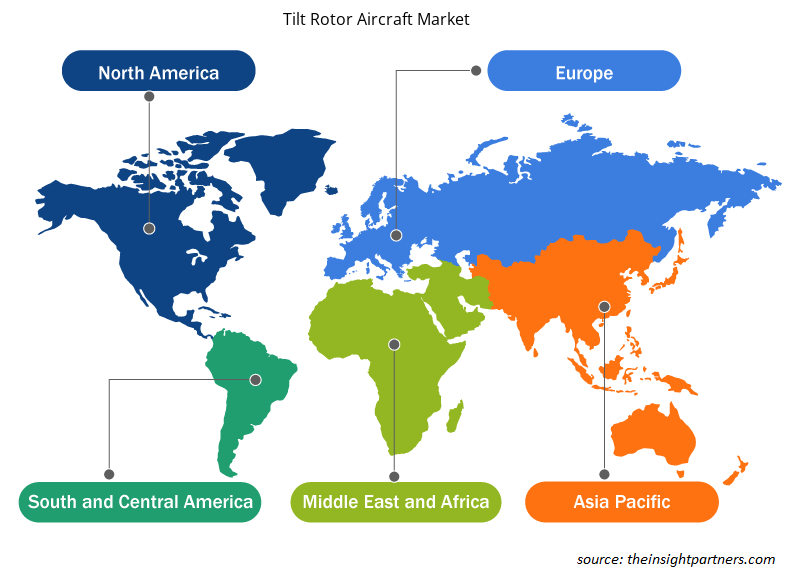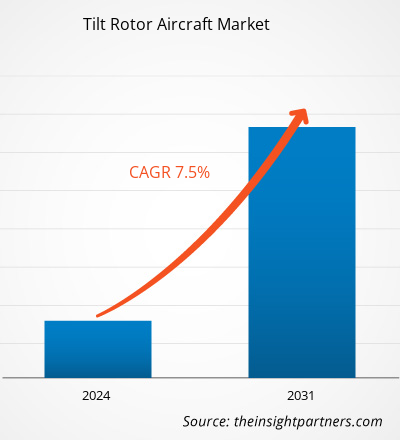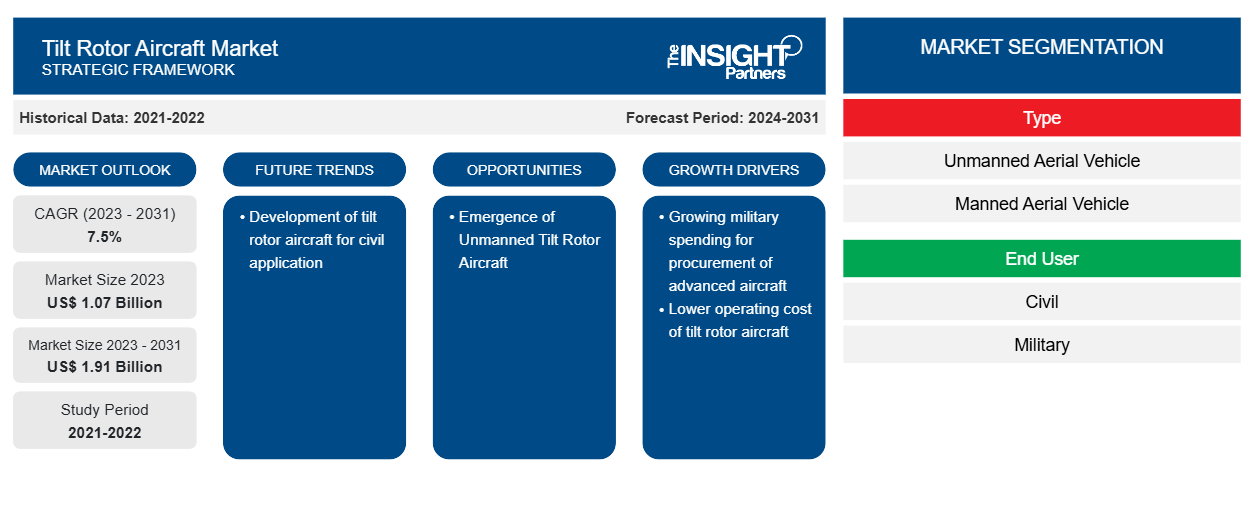Si prevede che la dimensione del mercato degli aeromobili a rotore basculante raggiungerà 1,91 miliardi di dollari entro il 2031 da 1,07 miliardi di dollari nel 2023. Si prevede che il mercato registrerà un CAGR del 7,5% nel periodo 2023-2031. È probabile che lo sviluppo di aeromobili a rotore basculante per applicazioni civili rimanga una tendenza chiave nel mercato.
Analisi del mercato degli aeromobili a rotore basculante
Gli operatori del mercato degli aeromobili a rotore basculante stanno sperimentando una significativa crescita aziendale anno dopo anno. Ciò è principalmente attribuito all'aumento del numero di utenti finali. L'aumento dell'approvvigionamento di aeromobili a rotore basculante per applicazioni militari e civili sta gradualmente promuovendo il potere contrattuale dei fornitori. Al momento, il potere contrattuale dei fornitori di aeromobili a rotore basculante è moderato, tuttavia, si prevede che scenderà a livelli bassi, poiché gli utenti finali stanno aumentando e i modelli sono costruiti con specifiche simili. L'aumento del numero di utenti finali riguarda principalmente l'aumento dello sviluppo di modelli di aeromobili a rotore basculante senza pilota per applicazioni civili e militari.
Panoramica del mercato degli aeromobili con rotore basculante
I veicoli aerei con equipaggio e i veicoli aerei senza equipaggio sono i due tipi di aeromobili a rotore basculante offerti sul mercato. Il numero di produttori di aeromobili a rotore basculante con equipaggio è relativamente basso. Attualmente, i modelli di aeromobili a rotore basculante con equipaggio sono disponibili presso le forze di difesa statunitensi e giapponesi. Il costo degli aeromobili a rotore basculante con equipaggio è uno dei principali fattori per la domanda inferiore. Tuttavia, con la commercializzazione dell'aeromobile a rotore basculante AW609 di Leonardo, che è circa 40 milioni di dollari in meno rispetto al V-22 Osprey, si incoraggerebbero gli acquirenti ad acquistare aeromobili a rotore basculante con equipaggio. Questo fattore viene analizzato per comprendere e descrivere il potere contrattuale degli acquirenti nei prossimi anni. Inoltre, i venditori che operano nel mercato degli aeromobili a rotore basculante si stanno anche concentrando principalmente sullo sviluppo di prodotti nuovi e innovativi per rimanere competitivi sul mercato.
Personalizza questo report in base alle tue esigenze
Riceverai la personalizzazione gratuita di qualsiasi report, comprese parti di questo report, o analisi a livello nazionale, pacchetto dati Excel, oltre a usufruire di grandi offerte e sconti per start-up e università
- Scopri le principali tendenze di mercato in questo rapporto.Questo campione GRATUITO includerà analisi di dati che spaziano dalle tendenze di mercato alle stime e alle previsioni.
Driver e opportunità del mercato degli aeromobili a rotore basculante
Crescente spesa militare per l'acquisto di aeromobili avanzati
Poiché le tensioni globali sono persistite negli ultimi anni, varie nazioni interessate pianificano e adottano misure per migliorare e ricapitalizzare lo stato di difesa. Le minacce sono in continua evoluzione, vale a dire, dalla forza convenzionale terrestre alla guerra ibrida. Per affrontare le minacce alla sicurezza e contrastare il terrorismo, i governi di diverse nazioni hanno già iniziato ad aumentare i loro budget per la difesa. Secondo lo Stockholm International Peace Research Institute (SIPRI), la spesa militare globale è salita a 2.443 miliardi di dollari nel 2023, il che rappresenta un aumento del 13,7% rispetto al 2022.
Le crescenti tensioni geopolitiche e le guerre tra alcuni paesi di diverse regioni stanno determinando elevati investimenti nel settore della difesa. Una parte significativa dell'investimento è dedicata all'approvvigionamento di velivoli militari avanzati e velivoli a rotore basculante. Ad esempio, a maggio 2023, Boeing ha ricevuto un contratto del valore di 482,3 milioni di dollari USA per la produzione e la consegna di quattro velivoli CMV-22B (Lotto 27) per le forze navali statunitensi. Pertanto, si prevede che il crescente approvvigionamento di velivoli a rotore basculante per applicazioni militari guiderà la crescita del mercato durante il periodo di previsione.
Emersione di aeromobili a rotore basculante senza pilota
Il rapido cambiamento nella guerra moderna ha spinto i governi ad allocare maggiori fondi alle rispettive forze armate. La maggiore allocazione del budget militare consente alle forze militari di impegnarsi nello sviluppo e nell'approvvigionamento di flotte di guerra avanzate, tra cui gli UAV. Gli UAV sono ampiamente utilizzati per raccogliere informazioni, sorveglianza, ricognizione, acquisizione di obiettivi, gestione dei danni in battaglia, consegna, trasporto, operazioni di combattimento e altre applicazioni. I ministeri di tutto il mondo stanno investendo ingenti somme di denaro con l'intenzione di modernizzare le forze armate. Attualmente, la modernizzazione della flotta è tra le pratiche più osservate seguite dall'industria aerospaziale e della difesa. Aziende come Textron Inc., China Aerospace Science and Technology Corp. e BNA - Nurol BAE Systems Air Systems Inc. offrono veicoli aerei senza pilota (UAV). Poiché il futuro della guerra aerea sta gradualmente passando dai veicoli aerei con pilota a veicoli aerei senza pilota, si prevede che gli operatori del mercato degli aeromobili a rotore basculante assisteranno a significative opportunità di crescita durante il periodo di previsione.
Analisi della segmentazione del rapporto di mercato degli aeromobili con rotore basculante
I segmenti chiave che hanno contribuito alla derivazione dell'analisi di mercato degli aeromobili a rotore basculante sono la tipologia e l'utente finale.
- In base al tipo, il mercato dei velivoli a rotore basculante è suddiviso in veicoli aerei senza pilota e veicoli aerei con equipaggio. Il segmento dei veicoli aerei con equipaggio ha detenuto una quota di mercato maggiore nel 2023.
- In base all'utente finale, il mercato degli aeromobili a rotore basculante è segmentato in civile e militare. Il segmento militare ha detenuto una quota di mercato maggiore nel 2023.
Analisi della quota di mercato degli aeromobili con rotore basculante per area geografica
L'ambito geografico del rapporto sul mercato dei velivoli a rotore basculante è suddiviso principalmente in quattro regioni: Nord America, Europa, Asia Pacifico e resto del mondo.
Il Nord America ha dominato il mercato nel 2023, seguito dalle regioni Asia Pacifico ed Europa. Inoltre, è probabile che il Nord America assista anche al CAGR più elevato nei prossimi anni. Gli Stati Uniti hanno rappresentato la quota di mercato più grande nel mercato nordamericano degli aeromobili a rotore basculante. Gli Stati Uniti sono il principale investitore mondiale in difesa e hanno la più grande flotta di aerei militari al mondo. Il governo degli Stati Uniti è anche noto per supportare la ricerca e lo sviluppo di sistemi avanzati di aeromobili e armi. Attualmente, il paese ha la più grande flotta di aeromobili a rotore basculante, V-22 Osprey, utilizzata dall'aeronautica militare statunitense, dalla marina militare statunitense e dal corpo dei marine degli Stati Uniti. Si prevede che il V-22 Osprey continuerà a dominare il mercato degli aeromobili a rotore basculante durante il periodo di previsione. Inoltre, il paese è noto per l'acquisto di un elevato numero di veicoli aerei senza pilota avanzati.
Approfondimenti regionali sul mercato degli aeromobili a rotore basculante
Le tendenze regionali e i fattori che influenzano il mercato dei Tilt Rotor Aircraft durante il periodo di previsione sono stati ampiamente spiegati dagli analisti di Insight Partners. Questa sezione discute anche i segmenti e la geografia del mercato dei Tilt Rotor Aircraft in Nord America, Europa, Asia Pacifico, Medio Oriente e Africa e Sud e Centro America.

- Ottieni i dati specifici regionali per il mercato degli aeromobili a rotore basculante
Ambito del rapporto sul mercato degli aeromobili a rotore basculante
| Attributo del report | Dettagli |
|---|---|
| Dimensioni del mercato nel 2023 | 1,07 miliardi di dollari USA |
| Dimensioni del mercato entro il 2031 | 1,91 miliardi di dollari USA |
| CAGR globale (2023-2031) | 7,5% |
| Dati storici | 2021-2022 |
| Periodo di previsione | 2024-2031 |
| Segmenti coperti | Per tipo
|
| Regioni e Paesi coperti | America del Nord
|
| Leader di mercato e profili aziendali chiave |
|
Densità degli attori del mercato degli aeromobili a rotore basculante: comprendere il suo impatto sulle dinamiche aziendali
Il mercato dei Tilt Rotor Aircraft Market sta crescendo rapidamente, spinto dalla crescente domanda degli utenti finali dovuta a fattori quali l'evoluzione delle preferenze dei consumatori, i progressi tecnologici e una maggiore consapevolezza dei vantaggi del prodotto. Con l'aumento della domanda, le aziende stanno ampliando le loro offerte, innovando per soddisfare le esigenze dei consumatori e capitalizzando sulle tendenze emergenti, il che alimenta ulteriormente la crescita del mercato.
La densità degli operatori di mercato si riferisce alla distribuzione di aziende o società che operano in un particolare mercato o settore. Indica quanti concorrenti (operatori di mercato) sono presenti in un dato spazio di mercato in relazione alle sue dimensioni o al valore di mercato totale.
Le principali aziende che operano nel mercato degli aeromobili a rotore basculante sono:
- Sistemi BAE Plc
- Bell Textron Inc
- Il boeing
- Industrie aerospaziali israeliane Ltd
- Leonardo SpA
- Società per azioni Lockheed Martin
Disclaimer : le aziende elencate sopra non sono classificate secondo un ordine particolare.

- Ottieni una panoramica dei principali attori del mercato degli aeromobili con rotore basculante
Notizie e sviluppi recenti sul mercato degli aeromobili a rotore basculante
Il mercato degli aeromobili a rotore basculante viene valutato raccogliendo dati qualitativi e quantitativi dopo la ricerca primaria e secondaria, che include importanti pubblicazioni aziendali, dati associativi e database. Di seguito sono elencati alcuni degli sviluppi nel mercato degli aeromobili a rotore basculante:
- Textron Inc (NYSE: TXT) ha annunciato oggi che Bell Textron Inc., una società Textron, si è aggiudicata il contratto di sviluppo per il programma Future Long-Range Assault Aircraft (FLRAA) dell'esercito americano. L'assegnazione si basa sul tiltrotor V-280 Valor di Bell, sviluppato e testato come parte del programma Joint Multi-Role Technology Demonstrator (JMR TD) iniziato nel 2013. Il V-280 è progredito attraverso la progettazione, la produzione e oltre tre anni di rigorosi test di volo che hanno fornito dati estesi che convalidano i vantaggi tecnici e operativi dell'aereo per la missione di assalto a lungo raggio. (Fonte: Textron Inc, comunicato stampa, febbraio 2022)
- La russa ZALA Aero presenta i droni a rotore basculante e a propulsione ibrida. Il rotore basculante ZALA VTOL combina le migliori qualità di un drone di tipo aeronautico e di un rotore basculante, e ha anche la capacità di cambiare la configurazione a seconda del compito da svolgere (Fonte: ZALA Aero, comunicato stampa, aprile 2021)
Copertura e risultati del rapporto sul mercato degli aeromobili a rotore basculante
Il rapporto "Dimensioni e previsioni del mercato degli aeromobili a rotore basculante (2021-2031)" fornisce un'analisi dettagliata del mercato che copre le seguenti aree:
- Dimensioni e previsioni del mercato degli aeromobili a rotore basculante a livello globale, regionale e nazionale per tutti i principali segmenti di mercato coperti dall'ambito
- Tendenze del mercato degli aeromobili a rotore basculante e dinamiche di mercato come driver, vincoli e opportunità chiave
- Analisi dettagliata delle cinque forze di Porter
- Analisi di mercato degli aeromobili a rotore basculante che copre le principali tendenze del mercato, il quadro globale e regionale, i principali attori, le normative e i recenti sviluppi del mercato
- Analisi del panorama industriale e della concorrenza che copre la concentrazione del mercato, l'analisi della mappa di calore, i principali attori e gli sviluppi recenti per il mercato degli aeromobili a rotore basculante
- Profili aziendali dettagliati
- Analisi storica (2 anni), anno base, previsione (7 anni) con CAGR
- Analisi PEST e SWOT
- Valore/volume delle dimensioni del mercato - Globale, Regionale, Nazionale
- Industria e panorama competitivo
- Set di dati Excel
Report recenti
Testimonianze
Motivo dell'acquisto
- Processo decisionale informato
- Comprensione delle dinamiche di mercato
- Analisi competitiva
- Analisi dei clienti
- Previsioni di mercato
- Mitigazione del rischio
- Pianificazione strategica
- Giustificazione degli investimenti
- Identificazione dei mercati emergenti
- Miglioramento delle strategie di marketing
- Aumento dell'efficienza operativa
- Allineamento alle tendenze normative





















 Ottieni un campione gratuito per - Mercato degli aeromobili a rotore basculante
Ottieni un campione gratuito per - Mercato degli aeromobili a rotore basculante